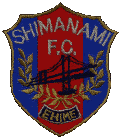
FC Imabari has a history that can match that of its main rivals in Shikoku. It was formed way back in 1976, under the name "Onishi Soccer Club", in the area of Ehime Prefecture adjoining the famous Kurushima Kaikyo Bridge, which links Shikoku to Honshu. Although it spent most of its first two decades in the Ehime Prefectural League, it earned promotion to the Shikoku Regional League in 2000 -- under the name Imao FC -- and immediately established itself as one of the strongest teams in the league.
To bolster its potential for future J.League participation, the team merged with a few feeder clubs associated with Ehime FC (which had just been promoted to the J.League) and changed its name to Ehime FC Shimanami. The team adopted a logo that appealed to local pride by including an image of the famous bridge. In the early 00s Shimanami FC finished near the top of the Shikoku League consistently, and remained one of the strongest still-amateur clubs in Shikoku, until its reorganization in 2012.


However, the team's growth trajectory stalled due to competition from larger rivals, for which Ehime FC Shimanami seemed to have no reply. WIth one J.League team already established in Ehime Prefecture (Ehime FC), there was neither the official (and political) interest nor the grassroots base to drive a similar groundswell of Prefectural and corporate support for Shimanami. In 2011, Ehime FC Shimanami won the Shikoku League and took part in the postseason playoffs to enter the JFL. Though it fell narrowly short of JFL admission, club officials recognised and seized the opportunity to establish a professional club structure, changing the team name to "FC Imabari", both to foster local feeling among residents of the prefecture's second-largest city, and to distinguish itself from Ehime FC (located in nearby Takamatsu).
Two years later, in 2013, the team again won the Shikoku League, and this time FC Imabari defeated all comers to make their way into the JFL for the first time. Over the winter break, as Imabari tried to lay the groundwork for future growth, a well-known figure from Japan's football history stepped into the picture. Former Japan National Team coach Takeshi Okada purchased a 51% stake in the team at the start of 2014, and held a high-profile press conference to announce FC Imabari's intention to join the J.League.
At about this time, FC Imabai adopted an informal mascot -- a rather generic yellow blob wearing a "crown" shaped like the Kurushima Kaikyo bridge, with a large merchant ship tucked into its "obi" (belt). The creature's name is "Bari", and it remains a very simple and amateurish design. Most observers expect the mascot to get an upgrade in the near future, as FC Imabari moves into a more "professional" environment.
With Okada providing guidance, the club picked up a number of aging veterans from the Kansai region, including former Gamba co-captain Hideo Hashimoto and former Portimonense midfielder Kodai Nakashima. Imabari also attracted corporate funding and wider fan support, allowing it to register as a J.League associate team in 2017. With former Sanfrecce coach Takeshi Ono at the helm, FC Imabari managed a third-place finish in the JFL in 2019, clearing the final hurdle to J.League admission. In 2020, FC Imabari will join the J3 as the J.League's 55th member.
Team Results: 2005-
| Year | . | Pts | GP | W | D | L | GF | GA | G.Dif |
|---|---|---|---|---|---|---|---|---|---|
| 2005 | 3 | 25 | 14 | 8 | 1 | 5 | 29 | 25 | +4 |
| 2006 | 3 | 26 | 14 | 8 | 2 | 4 | 43 | 21 | +22 |
| 2007 | 6 | 10 | 14 | 3 | 1 | 10 | 25 | 50 | -25 |
| 2008 | 3 | 24 | 14 | 7 | 3 | 4 | 19 | 19 | +0 |
| 2020 | 7 | 55 | 15 | 10 | 9 | 39 | 27 | +12 |
